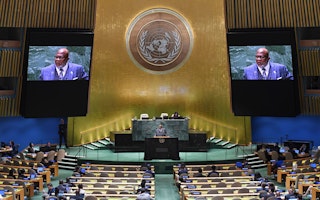It’s Time to Face Up to a Worsening Pandemic Debt Crisis

To support the many countries now struggling to service their international debts, Open Society has launched a campaigning initiative focused on the short-term emergency as well as the root causes of poverty and injustice embedded in international finance. Open Society’s Vanessa Jimenez recently spoke with the Latin American Network for Social and Economic Justice’s Patricia Miranda about the sovereign debt crisis.
How much impact has COVID-19 had on the ability of Latin American countries to provide needed services to their people?
The countries of Latin America already had fiscal deficits even before the pandemic. Then, in the first half of 2020, their governments saw drops in tax revenues of between 22 and 30 percent, due to the broad-based economic paralysis.
This made their fiscal shortfalls worse and left limited room to deal with the health crisis itself as well as other important issues such as addressing the climate crisis or maintaining our social safety nets—which were more important than ever as people lost their livelihoods because of the lockdowns and increased unemployment.
This all led to an increase in internal and external debt, as government borrowing was seen as the only way of combatting the pandemic. So now in Latin America, we have countries with unsustainable levels of debt.
How would you like the global financial community to respond?
The steps taken by the global financial community—the International Monetary Fund and the members of the G20—are insufficient for dealing with what is the largest global crisis we have seen in more than a century.
The Debt Servicing Suspension Initiative covers just 5 percent of the debt servicing costs of the developing countries and only puts the cost of this debt burden into the future. The Common Framework for Debt Treatments beyond the DSSI, meanwhile, which is supposed to promote debt restructuring with the participation of all creditors, only covers 73 eligible countries.
Both initiatives leave Latin American states on the sidelines, classifying them as middle-income countries based on a GDP per capita indicator that hides several economic, social, and climate-related vulnerabilities. That’s why these initiatives must stop looking only at a country’s capacity to pay debt; the broader costs that will result from paying back debt during this crisis matter, too. It’s only right, then, that Latin America’s voice is heard in the process of developing solutions to this crisis.
Our countries need a reduction in the burden of debt through the cancellation of debt servicing, even as they are engaged with a debt restructuring process. So, they need access to concessional financing. It is essential to allow countries that are currently in this condition, to use some of their international reserves in the form of Special Drawing Rights (SDRs) to address this social and economic crisis.
What would Latin American countries be able to do if they are granted additional SDRs?
SDRs provide an important support above all for middle-income countries, that have no access to concessionary funding. Receiving SDRs can provide reserve assets that strengthen a country’s external position in the context of this crisis. Ideally, these reserve assets do not remain in foreign banks but are used to enable the importing of vaccines or to include fiscal support in national budgets for health care, social services, economic stimulus, and climate issues.
What challenges are there in terms of providing SDRs to countries that need them?
SDRs are the only source of liquidity for middle-income countries that do not come with debt or austerity conditions. However, the amount of SDR support available is insufficient to meet the urgent needs of developing countries. That’s why civil society groups are calling for the issuance of $3 billion of new SDRs, which is much less than half the total spent by the developed world so far on economic stimulus packages.
This could be addressed through a reassigning of the SDRs from high-income countries to low- and middle-income countries, given that two-thirds of the new issuance will go to developed countries, with a strong possibility that they will not be used. It would be far better to cede new SDRs to the countries that need them, using a system set up to provide concessional financing.
Your organization has created briefing papers on SDRs and the debt situation in Latin America, and you’ve also produced a video [see below]. Who do you see as your audience?
The debt question has historically affected people in various ways, and it is important to understand its magnitude, the burden that it represents for future generations, and its impacts on vulnerable groups. It’s also important to know about alternative fiscal and monetary approaches that exist to address crises in the short, medium, and long term. We produced this information to empower our citizens, to promote a dialogue with governments in this hemisphere, and to search for solutions that will avoid repeating this crisis in the future.

The Latin American Network for Social and Economic Justice is a grantee of the Open Society Foundations.


